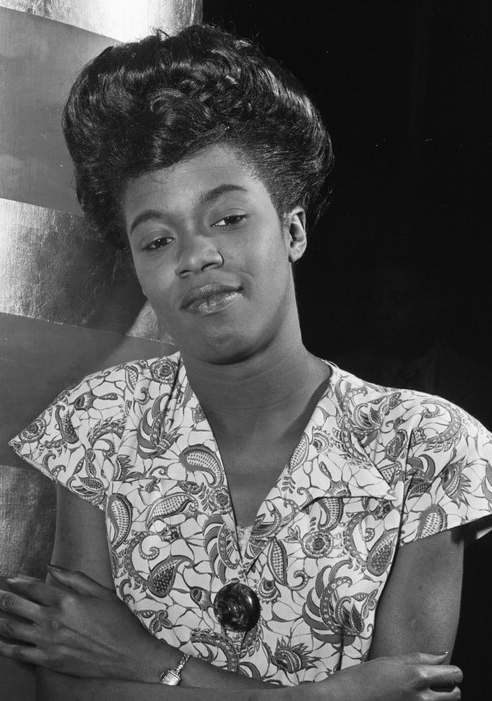In order to
reference my nostalgia for the interview, I decided to call
up some entries of her performances available on YouTube.
The jock was thrilled because he had never seen the Divine
One but worshipped her work on recordings. So we held the
interview and I was able to point out my thoughts while
we watched her perform on the screen. After the session
he suggested that I use the same approach for my readers.
I thought about what he said and can now have some critical
essay encounters with readers who can also listen and watch
her on the YouTube. I chose an entry that Sara made in Europe
in 1964. Here’s essentially what I
said during the interview:
In 1942, after
winning one of the Apollo theater’s singing contests,
Sarah opened for Ella Fitzgerald for a week. She had been
born in Newark, started studying piano at age seven, sung
in the choir, and at 18 was already an impressive jazz vocalist.
Soon, after being recommended by Billy Eckstine who was
performing with the Earl Hines band, she joined Hines and
began performing alongside beboppers Charlie Parker, Dizzy
Gillespie and Benny Green. Eckstine left Hines in 1943 to
form a band his own band and had Gene Ammons, Miles Davis,
Kenny Dorham, Dexter Gordon and Lucky Thompson together
with Gillespie arranging and playing. Sarah accepted an
invitation to join this pioneering bebop band and recorded
her first song on December 5, 1944. Her immense talent impressed
critics everywhere and she left the Eckstine band and shortly
began a solo singing career.
Vaughan possessed
advanced keyboard musicianship, a 3-octave voice, and vast
knowledge of jazz history and  tradition.
Unlike Fitzgerald, Louis Armstrong and other jazz immortals,
she did not have an experienced producer to shape her career
and had to do her own managing. She engineered a remarkable
recording contract with Mercury records where she recorded
many inane but lucrative hits such as “Broken-hearted
Melody, “Make yourself Comfortable” and “Whatever
Lola Wants.” Fortunately, Mercury had a jazz division
under it's EmArcy label so she also began a career in jazz
recording that led to legendary performances.
tradition.
Unlike Fitzgerald, Louis Armstrong and other jazz immortals,
she did not have an experienced producer to shape her career
and had to do her own managing. She engineered a remarkable
recording contract with Mercury records where she recorded
many inane but lucrative hits such as “Broken-hearted
Melody, “Make yourself Comfortable” and “Whatever
Lola Wants.” Fortunately, Mercury had a jazz division
under it's EmArcy label so she also began a career in jazz
recording that led to legendary performances.
So, at the outside
of the “Misty” recording on our YouTube list,
Vaughan introduces herself in typical modest fashion and,
after briefly dialoguing with the audience, hits the tonic
opening of “Misty” without piano accompaniment.
And, as she launches the initial 4-bar phrase, she immediately
begins her improvised melodic transformations -- she changes
notes at will substituting her own notes (often more serviceable)
for those of the original song. And while some of the changes
violate the established rhythm pattern, she always manages
to fit everything together with ease. We also immediately
notice the subtlety of her vibrato phrase endings performed
unobtrusively and delicately. At the conclusion of the “Misty
“ performance Vaughan inserts a thoughtful diminished
chord sequence that compliments the tune’s primary
structure and is not merely a pleasant sounding denouement.
These adventures
in melodic reconstructions and rhythmic variations became
the trademark of Vaughan’s jazz style and went on
to become a paradigm for singers that followed including
Betty Carter, Nina Simone, Dakota Staton, Cassandra Wilson
and a host of contemporary vocalists. And for listeners
who focus on her immense range, the YouTube entry of Vaughan
singing “My
Funny Valentine” with only intermittent
piano accompaniment is a must. The Tokyo
recording is the best.
Vaughan’s
career began auspiciously and as she encountered so many
bebop pioneers she became a fixture of vocal bebop literature.
She recorded George Shearing’s “Lullaby of Birdland”
-- a vocal national anthem -- several times with the most
successful performance alongside trumpeter Clifford Brown
(Vaughan was one of the earliest to recognize Brown’s
astounding hard bop technique and sought him out for her
1954 Album and gave him headline billing, “Sarah
Vaughan with Clifford Brown” when he
was still virtually unknown.
Vaughan was
a shy person. I was with Johnny Hartman at Harlem’s
Red Rooster one evening after producing a show with Johnny
for my Pace University Jazz series. The room was very dark
as Johnny, his wife Teddi, and I squeezed ourselves into
a corner table alongside people I didn’t know. I was
seated next to a lovely lady who I introduced herself saying
“Hi, I’m Sarah.” It was only after the
stage set ended and the lights went up that I realized who
Sarah really was.
Her shyness
came out again year's later at a Newport Jazz Festival concert
in NY that I attended as a journalist. She was introducing
a tune by Ivan Lins dubbed “The Island.” It
became a bossa nova hit recorded by a host headliners. The
tune had several intimate but tasteful sexual lyrics and
Vaughan actually paused in the middle of singing to indicate
her embarrassment. Later in her dressing room she apologized
to the press for her blushing
bashfulness.
Vaughan garnered
dozens of awards, Grammy nominations, honorary degrees etc.
Her Wikipedia biography is well written with considerable
gusto and contains quotes by major writers and jazz luminaries.
The commentary contains superlative tribute delivered by
those who really know music and vocalist